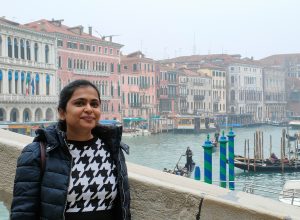Srushti Goud
 Personal Bio
Personal Bio
Srushti Goud is a cultural heritage researcher, architect and art-lover from India. She completed her Bachelor of Architecture from M S Ramaiah Institute of Technology, Bangalore, India in 2013. In 2015, she completed International Master’s in Interior Architecture and Design (History, Theory and Criticism) from CEPT University, Ahmedabad, India. Her PhD research at Unito, deals with the communication of Cultural Heritage Values in our digital age. She wishes to bridge the gap between the research and practice of heritage communication.
Topic: Value Communication for Cultural Heritage: Operational Workflow for Digital Environments
Background and Methodology
Cultural Heritage(CH) is a kaleidoscope of our shared human history in all its tangible and intangible forms. Cultural Heritage Communication (CHComm) is the transfer of authentic heritage information and its associated values. Every individual and by extension, communities made up of individuals associate heritage values with heritage properties and assets that they consider as central to their history and identity. All the cultural traditions have associated values with heritage properties, and these values may have changed, evolved, cherished and been forgotten and remembered again over centuries. Digital communication has impacted all fields of human endeavour and cultural heritage is no exception. There is a need for heritage experts, institutions and local communities to maintain a digital presence that supports global sharing of CH knowledge and increases audience participation in heritage conservation and communication. However, digital heritage projects often do not pay enough attention to certain aspects of heritage communication. Often, digital CHComm projects fail to effectively communicate the associated cultural heritage values and there is no systematic method to address such issues.
This research explores how the information uncovered by heritage professionals can effectively be communicated to groups of willing and interested participants in CHComm. The research shows that there is a need for a CH values motivated approach to CHComm especially in digital environments. After a thorough analysis of the current state of the art, an eight- stage operational workflow is formulated that undertakes the uncovering, verification and inclusion of cultural heritage values in digital CHComm projects. The workflow begins with a collection and sorting of CH values by relative importance which are then presented to experts and non-experts for an initial vetting. These sorted and vetted set of CH values are then enhanced with all the multiple perspectives after which they are contextualised for communication environments. At this point the first prototype of the digital CHComm environment is developed and tested for the effectiveness of communication of CH values. The results from this targeted evaluation are then used to create an improved Prototype 2 which can be treated as the final version. In the thesis, the proposed workflow is compared against two existing digital CHComm examples and then it is applied to three real-world scenarios.
Outcome
Three different applications are created to apply and review the operational workflow. The first case deals with the creation of a value-based digital multimedia application for the artefacts under the Menorah collection at the Hecht Museum in Haifa, Israel. This study validated the efficacy of the operational workflow in communicating CH values to willing and interested participants. The second case is a standalone digital multimedia application that tells the story of the Virupaksha Temple at Pattadakal, Karnataka, India. This second case also necessitates a study on digital outreach to digital communities across the internet. The third case is a companion application for the existing BeA-ViR system, of the BeArchaeo archaeological project. The BeArchaeo project deals with the excavation at Tobiotsuka Kofun, a funerary burial mound in Soja city, Okayama prefecture, Japan. The observations from the implementation of the three cases and the results from the public testing of the workflow in each of these separate instances are compared to assess the method and provide a better understanding of how a designer can reduce the communication gap pertaining to CH values between the heritage experts and the non-expert communities. The thesis has resulted in two publications so far and more are planned.
Get in touch:
Mail: goudsrushti@gmail.com
LinkedIn: www.linkedin.com/in/srushti-goud
Tech4Culture Fellow – Call 2 (2019)
Supervisor: Vincenzo Lombardo, Informatics Department
